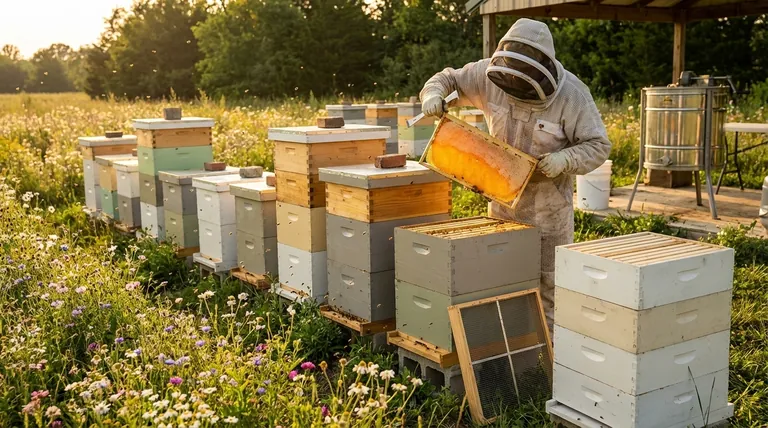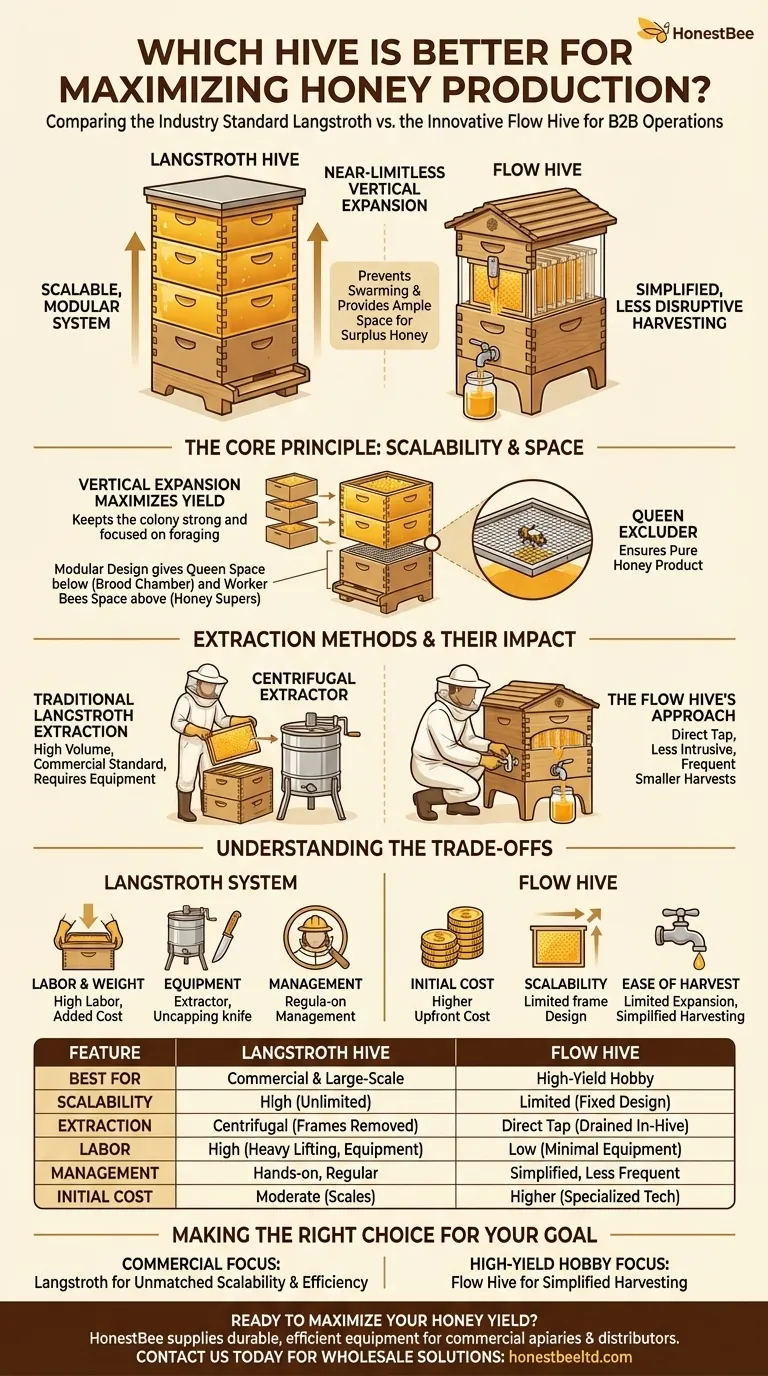For maximizing honey production, the Langstroth hive is the established industry standard. Its design is fundamentally centered on scalability and management efficiency, allowing a strong colony to produce a significant honey surplus. This modular system has become the go-to choice for commercial apiaries and serious hobbyists focused on high yields.
The key to maximizing honey production is not found in a single hive model, but in a system that allows for near-limitless vertical expansion. This prevents the colony from swarming and provides ample space for storing surplus honey, which is the core principle behind the Langstroth hive's effectiveness.

The Core Principle: Scalability and Space
The most significant factor driving honey production is the hive's ability to expand in lockstep with the colony's growth and the availability of nectar. A crowded hive is a hive preparing to swarm, which dramatically reduces your honey-producing workforce.
How Vertical Expansion Maximizes Yield
A hive's architecture directly impacts its output. The Langstroth design allows beekeepers to add boxes, or "supers," vertically.
This modularity provides two critical advantages: it gives the queen ample room to lay eggs in the lower boxes (the brood chamber) and offers nearly unlimited space above for worker bees to store honey.
Preventing Swarms to Keep the Workforce Strong
When bees feel they are running out of space, their natural instinct is to swarm—the queen leaves with roughly half the colony to find a new home.
By consistently adding supers ahead of the colony's needs, you effectively remove this trigger. A larger, non-swarming colony means more forager bees collecting nectar, which directly translates to a larger honey harvest.
The Critical Role of the Queen Excluder
To ensure the honey supers contain only honey, beekeepers use a queen excluder. This is a screen with openings large enough for worker bees to pass through but too small for the queen.
Placing it between the brood chamber and the honey supers keeps the queen from laying eggs where you plan to harvest. This simplifies extraction and ensures a pure honey product.
Extraction Methods and Their Impact on Production
While the hive's structure is crucial for honey storage, the method of extraction also plays a role in overall yield and efficiency.
Traditional Langstroth Extraction
Langstroth hives rely on centrifugal extraction. The beekeeper removes frames of honey, scrapes off the wax cappings, and spins them in an extractor machine.
This method is highly efficient for processing large quantities of honey at once. It's the standard for any commercial or large-scale operation where volume and speed are paramount.
The Flow Hive's Innovative Approach
The Flow Hive introduces a different philosophy focused on the ease and frequency of harvesting. Its specialized frames allow honey to be drained directly from the hive via a tap.
This method is far less intrusive to the bees and eliminates the need for a separate extractor. For the hobbyist, this can mean more frequent, smaller harvests throughout the season, potentially increasing the total yield by minimizing disruption to the colony.
Understanding the Trade-offs
No single system is perfect for every beekeeper. The choice between hive types involves clear trade-offs in labor, cost, and management style.
Labor, Weight, and Equipment
The primary drawback of the Langstroth system is the physical labor involved. A deep super full of honey can weigh over 80 pounds (36 kg), and managing a multi-box hive requires significant heavy lifting.
Furthermore, it necessitates an investment in extraction equipment, such as an uncapping knife and a centrifugal extractor, which adds to the overall cost.
Management Complexity
A Langstroth hive is not a passive system. Maximizing its potential requires active management, including regular inspections to assess colony health and determine the precise time to add or remove supers.
This hands-on approach offers greater control but also demands more knowledge and time from the beekeeper.
The Flow Hive's Cost and Considerations
The Flow Hive's primary trade-off is its higher initial cost. The specialized technology within the frames makes it a more significant upfront investment than a standard Langstroth setup. While it excels in simplifying extraction, its production ceiling for a large-scale commercial operation has not been proven to exceed the traditional Langstroth model.
Making the Right Choice for Your Goal
Your ideal hive depends entirely on your operational scale and beekeeping philosophy.
- If your primary focus is commercial or large-scale production: The Langstroth hive is the unmatched industry choice for its proven scalability, efficiency, and standardization.
- If your primary focus is high-yield hobby beekeeping with minimal equipment: The Flow Hive offers a compelling advantage with its simplified, less disruptive harvesting method.
- If your primary focus is a balance of high potential and versatility: The standard Langstroth system remains the global benchmark, offering the highest possible honey yields for those willing to engage in its management demands.
Ultimately, the best hive is the one that empowers you to work in partnership with your bees to achieve your specific production targets.
Summary Table:
| Feature | Langstroth Hive | Flow Hive |
|---|---|---|
| Best For | Commercial & large-scale production | High-yield hobby beekeeping |
| Scalability | High (unlimited vertical expansion) | Limited (fixed frame design) |
| Extraction Method | Centrifugal extractor (frames removed) | Direct tap (honey drained in-hive) |
| Labor Intensity | High (heavy lifting, equipment needed) | Low (minimal equipment, less disruptive) |
| Management | Hands-on, regular inspections required | Simplified, less frequent intervention |
| Initial Cost | Moderate (scales with operation size) | Higher (specialized frame technology) |
Ready to maximize your honey yield?
HONESTBEE supplies beekeeping supplies and equipment to commercial apiaries and beekeeping equipment distributors through wholesale-focused operations. Whether you're scaling a commercial Langstroth operation or optimizing a high-yield hobby setup, we provide the durable, efficient equipment you need to succeed.
Contact us today to discuss your apiary's needs and discover how our wholesale solutions can boost your production.
Visual Guide

Related Products
- HONESTBEE Professional Long Handled Hive Tool with Precision Cutting Blade
- HONESTBEE Advanced Ergonomic Stainless Steel Hive Tool for Beekeeping
- Professional Dual-End Stainless Steel Hive Tool for Beekeeping
- Honey Flow Garden Bee Hive Flow Hive Best Beehive for Beginners
- Professional Drop-Style Hive Handles for Beekeeping
People Also Ask
- What is a hive tool used for in beekeeping? Your Essential Guide to Hive Management
- What is the hive tool used for? The Essential Multi-Tool for Every Beekeeper
- Why do hive tools have a hole? Unlock the Secret to Efficient Beekeeping
- What are the features of a regular hive tool? The Essential Multi-Tool for Every Beekeeper
- How can a hive tool be used to remove propolis and burr comb? Master Hive Maintenance for a Healthy Colony



















